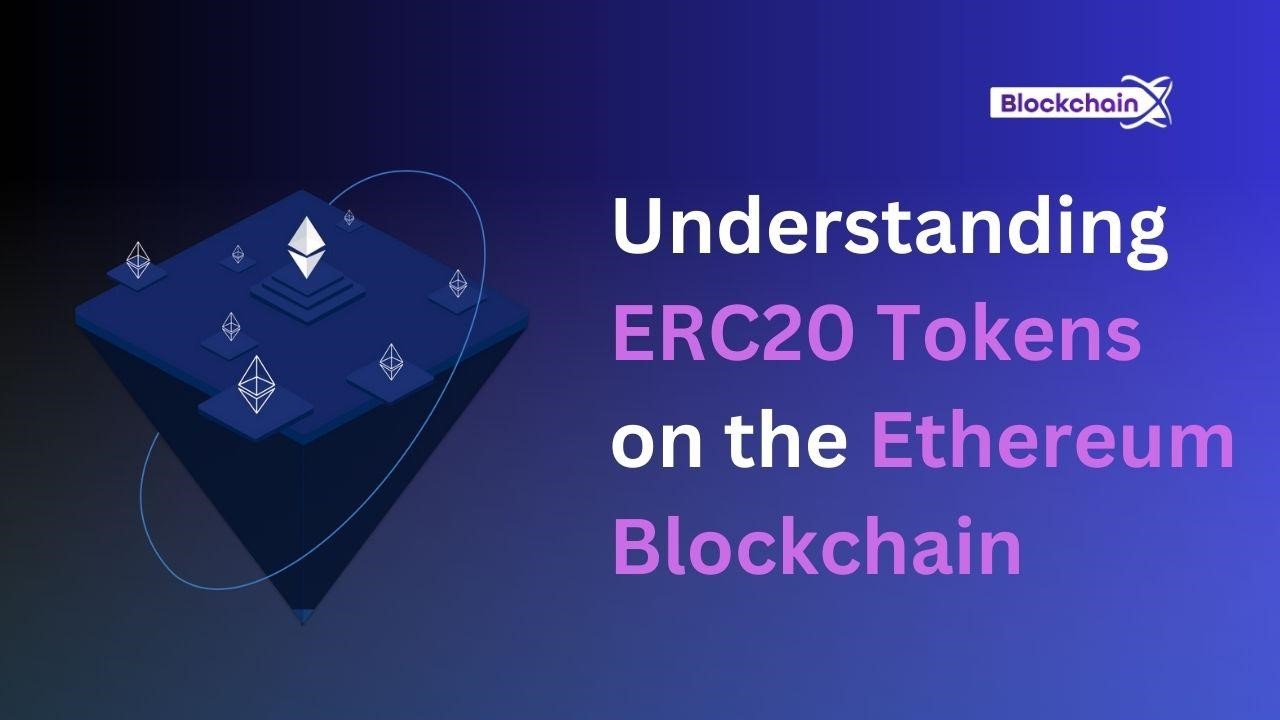ERC-20 is the technical standard used to issue and implement tokens on the Ethereum blockchain. This standard was proposed in November 2015 by Ethereum developer Fabian Vogelsteller.
This standard describes a general set of rules that must be followed for tokens to function properly within the Ethereum ecosystem. ERC-20 is not a piece of software or code, for this reason. Instead, it can be described as a technical guideline or specification.
What are ERC-20 Tokens
If ERC-20 is a technical standard or set of rules that must be implemented, ERC-20 tokens are tokens that are created and used on the Ethereum platform.
ERC-20 tokens follow a number of to create ERC20 token standards so they can be shared, exchanged for other tokens, or transferred into a crypto wallet.
The Ethereum community created these standards with three optional rules and six BASIC rules
Choice Rules
- Token Name
- Symbols
- Decimal (up to 18)
Basic Rules
- totalSupply
- balanceOf
- transfer
- transferFrom
- approve
- allowance
What is Ethereum?
To understand ERC-20 you must first know what Ethereum is. Ethereum is a decentralized computer network that has two basic functions.
Blockchain that can record transaction traces and a virtual machine that can create smart contracts. With these two functions, Ethereum can support decentralized applications (DApps). DApps are built on the existing Ethereum blockchain, on top of the underlying technology.
Depending on the purpose, DApps can create ERC-20 tokens as currency, as shares in a company, as points in a loyalty program, or even as proof of ownership of a house or some gold.
The Role of Smart Contracts
Smart Contracts are used to create ERC-20 Tokens. Apart from that, it is also used to facilitate token transactions and record token balances in an account. Smart contracts are written in a “Solidity” programming language based on If-This-Then-That (IFTTT) logic.
What then happens after the smart contract creates a token?
Once created, a token can be exchanged, spent, or given to someone else.
ERC-20 is a universal language used by all tokens in the Ethereum network. ERC-20 allows a token to be exchanged for another token.
It’s like we want to create a crypto-casino . Just like casinos in general, we want all players who come to use the chips provided by the casino, to keep it simple.
So players exchange their fiat money for tokens that we have and then play at the poker table.
How it Works for ERC-20
For example, let’s look at the respective regulations for ERC-20 in our crypto-casino .
Starting from the optional rules :
- Token Name: Blu Chip
- Symbol: BLU
- Decimals: 2*
*means the smallest token value that can be used in a bet is 0.01 BLU. We could use the decimal up to 18 so that the smallest bet value is 0.000000000000000001 BLU, but for this example we’ll just keep it simple.
For the basic rules:
- [ TotalSupply ] shows the total supply of ERC-20 Tokens created.
Example: The first thing our Casino needs is how many BLU tokens are rotated. Let’s just say that at our poker table there are 10 BLUs and it is filled by 10 players.
Basic rules in the ERC-20 standard
- [ Transfer ] means allowing tokens to be transferred in a specified amount from [ TotalSupply ] to one’s account.
Before the game starts, players must get BLU tokens from the dealer; each player gets 1 BLU.
Transfer is a basic rule in the ERC-20 standard
- [ BalanceOf ] is a function to return a number of tokens from an existing address to the account.
In the first round of poker, five players look at the cards in their hands and decide not to play.
The other five players decide to bet 0.5 BLU. With the [ BalanceOf ] function , we can see that there are 5 players who have 1 BLU and 5 players who have 0.5 BLU.
[balanceOf] is a basic rule in the ERC-20 standard
- [ TransferFrom ] is a function that allows a user to transfer his tokens to another user.
When one player wins the first round, he gets 2.5 BLU from the other player.
But in order for him to get tokens from other players, he needs [ TransferFrom ]. Because without the [ Transferfrom ] function, there is nothing to prevent one player from stealing BLU from another player.
[balanceOf] is a basic rule in the ERC-20 standard
- [ Approve ] checks transactions for the total token supply. Make sure there is no less or more.
Another way to maintain the integrity of our crypto-casino is to ensure that no one brings extra BLU to the poker table.
So, Approve allows exchanges to occur by checking that the number of BLUs on the table remains 10.
[approve] is a basic rule in the ERC-20 standard
- [ Allowance ] is a function that checks the balance in the user’s account and will cancel the transaction if there are not enough tokens.
In our crypto-casino , you cannot use credit. So, we need to ensure that each player has enough BLU to bet.
If a player only has 1 BLU, then he cannot bet 2 BLU.
Example of ERC-20 Use
- Fundraising: Companies and startups can use ERC20 tokens for fundraising through Initial Coin Offerings (ICOs) or Security Token Offerings (STOs).
- Payment System: Businesses can create their own ERC20 tokens as a way of payment within their ecosystem.
- Rewards System: ERC20 tokens can be converted into points for loyalty programs, rewarding users for utilizing certain services or platforms.
- Decentralized Applications: ERC20 tokens can motivate users to contribute to decentralized applications (dApps). For example, a dApp that offers file storage might reward users with ERC20 tokens for providing unused disk space.
Advantages of ERC-20
The ERC20 token development company standard is critical to the growth of the Ethereum ecosystem and the broader blockchain industry. This standard offers several advantages:
- Standardization
One of the main benefits of ERC-20 is that it provides a common set of rules that all tokens must adhere to. This makes it easier for developers to create interoperable tools, exchanges, wallets, and dApps.
- Wide Adoption
Due to its standardization, it has been widely adopted by the Ethereum community. Most exchanges , wallets and service providers support ERC-20 tokens out of the box, ensuring that new tokens can be easily accessed and stored.
- Ease of Manufacturing
Creating new ERC-20 tokens is relatively easy. This simplicity has allowed many startups and projects to issue their own tokens, leading to an Initial Coin Offering (ICO) boom in 2017 and beyond.
- Interoperability
Due to standardized rules and widespread adoption, ERC-20 tokens can be used and integrated easily across various platforms, exchanges, and services.
- Smart Contracts
The ERC-20 standard is built on the Ethereum platform, which allows the use of smart contracts . This means that tokens can have complex behavior and rules coded into them, enabling a wide variety of applications beyond simple transfers.
- Decentralization
Like all assets on the Ethereum blockchain, ERC-20 tokens operate in a decentralized manner. This ensures that tokens are not controlled by a central authority and can be transacted peer-to-peer.
- Community Support
Given the widespread use of the ERC-20 standard, there is a large community of developers and users who can offer support, develop tools, and provide input for improvements.
- Compatibility with DApps
ERC-20 tokens can be easily integrated into decentralized applications (DApps) on the Ethereum platform, enabling functionality such as in-app currency, rewards, and more.
Disadvantages of ERC 20
ERC-20 is not perfect. There are still some shortcomings.
- No Transfer Confirmation
Standard ERC-20 transfer functions do not return a success or failure status. This means that if you send tokens to a contract that isn’t set up to handle them, they could be lost forever.
- Batch Transfer Not Supported
The ERC-20 standard does not support sending tokens to multiple recipients in a single transaction. This can increase costs when trying to distribute tokens to many addresses.
- Different Applications
Although the standard provides basic guidelines, different tokens may have slight variations in their implementation, which can sometimes cause problems when interacting with other systems or platforms.
- Gas Fees
Every transfer or interaction with ERC-20 tokens requires gas. When the Ethereum network becomes congested, gas prices can spike, making transactions and smart contract interactions expensive.
- No Native Staking Mechanism
The ERC-20 standard does not provide a built-in staking mechanism . Projects wishing to implement staking typically need to develop additional smart contracts or adopt another token standard that supports staking directly.
- Scalability
Like everything on the Ethereum mainnet , ERC-20 tokens inherit Ethereum’s scalability problems. This can sometimes cause slow transaction times and high fees during network congestion.
- Duplication and Fraud
The ease of creating ERC-20 tokens has also led to the proliferation of fraudulent tokens or tokens with dubious intentions. This sometimes makes it difficult for investors to differentiate between legitimate projects and those that are scams.
Example of an ERC-20 Token
All tokens in the Ethereum platform are ERC-20 tokens. When this article was written, the number was 245,148 tokens, including the following.
- Tether (USDT)
Tether is a type of “stablecoin” whose value is pegged to a stable asset, such as the US dollar. Essentially, for every USDT token in circulation, there must be an equivalent amount of real US dollar reserves, keeping the token value close to US$1.
USDT is generally used as a trading pair and needs to be transferred via exchange for a faster process with affordable fees.
- Chainlink (LINK)
Chainlink is a decentralized oracle network that allows smart contracts on Ethereum to securely connect to external data sources, APIs, and payment systems.
Chainlink LINK tokens are used to pay for services within the network. The decentralized nature of Chainlink ensures that smart contracts have access to reliable and tamper-proof data feeds .
- Maker (MKR)
The DAI stablecoin is run by a decentralized autonomous organization called MakerDAO. Unlike USDT, which is backed by real-world assets in banks, DAI maintains its peg through the Ethereum system and collateralized governance. The MKR token is used for governance in the MakerDAO system. MKR holders can vote on proposals and system parameters.
Choice of ERC-20 Wallets
- MetaMask
MetaMask is a non-custodial wallet that can be accessed via a Google Chrome extension and is available on the Play Store or App Store. This wallet supports all ERC-20 tokens, as well as other selected networks. MetaMask provides easy access to decentralized exchanges.
- MyEtherWallet
MyEtherWallet is an ERC20-only wallet that supports iOS and Android applications. This wallet is equipped with various features, such as ERC20 token exchange, staking , and so on. This wallet also allows users to store NFTs and access decentralized exchanges.
- Trust Wallet
Trust Wallet is a non-custodial multi-crypto wallet application that gives users complete control over their digital assets, from cryptocurrencies to non-fungible tokens. Trust Wallet currently supports 70 blockchains and over 9 million crypto assets.
Conclusion
Understanding the ins and outs of the ERC-20 standard is essential for anyone delving into the world of Ethereum-based tokens. As the backbone of many tokens on the Ethereum blockchain, ERC-20 has set the benchmark for token standards, ensuring interoperability, security and a unified approach.
As the blockchain landscape continues to evolve, ERC-20’s relevance remains undiminished, a testament to its robust design and widespread adoption.
Author Bio: Ragunath.T is a Digital Marketing Executive at ERC20 Token development company. He designs marketing strategies with the intention of using high-quality content to educate and engage audiences. His specialties include social media marketing specialist, SEO, and he works closely with B2B and B2C businesses, providing digital marketing strategies that gain social media attention and increase your search engine


